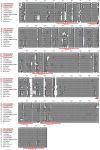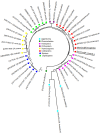Silencing the Olfactory Co-Receptor RferOrco Reduces the Response to Pheromones in the Red Palm Weevil, Rhynchophorus ferrugineus
- PMID: 27606688
- PMCID: PMC5015987
- DOI: 10.1371/journal.pone.0162203
Silencing the Olfactory Co-Receptor RferOrco Reduces the Response to Pheromones in the Red Palm Weevil, Rhynchophorus ferrugineus
Abstract
The red palm weevil (RPW, Rhynchophorus ferrugineus), one of the most widespread of all invasive insect pest species, is a major cause of severe damage to economically important palm trees. RPW exhibits behaviors very similar to those of its sympatric species, the Asian palm weevil (R. vulneratus), which is restricted geographically to the southern part of Southeast Asia. Although efficient and sustainable control of these pests remains challenging, olfactory-system disruption has been proposed as a promising approach for controlling palm weevils. Here, we report the cloning and sequencing of an olfactory co-receptor (Orco) from R. ferrugineus (RferOrco) and R. vulneratus (RvulOrco) and examine the effects of RferOrco silencing (RNAi) on odorant detection. RferOrco and RvulOrco encoding 482 amino acids showing 99.58% identity. The injection of double-stranded RNA (dsRNA) from RferOrco into R. ferrugineus pupae significantly reduced RferOrco gene expression and led to the failure of odor-stimulus detection, as confirmed through olfactometer and electroantennography (EAG) assays. These results suggest that olfactory-system disruption leading to reduced pheromone detection holds great potential for RPW pest-control strategies.
Conflict of interest statement
The authors declare that they have no conflicts of interest.
Figures







Similar articles
-
Silencing sensory neuron membrane protein RferSNMPu1 impairs pheromone detection in the invasive Asian Palm Weevil.Sci Rep. 2024 Jul 17;14(1):16541. doi: 10.1038/s41598-024-67309-x. Sci Rep. 2024. PMID: 39019908 Free PMC article.
-
Identification of the genes involved in odorant reception and detection in the palm weevil Rhynchophorus ferrugineus, an important quarantine pest, by antennal transcriptome analysis.BMC Genomics. 2016 Jan 22;17:69. doi: 10.1186/s12864-016-2362-6. BMC Genomics. 2016. PMID: 26800671 Free PMC article.
-
Deorphanizing an odorant receptor tuned to palm tree volatile esters in the Asian palm weevil sheds light on the mechanisms of palm tree selection.Insect Biochem Mol Biol. 2024 Jun;169:104129. doi: 10.1016/j.ibmb.2024.104129. Epub 2024 May 3. Insect Biochem Mol Biol. 2024. PMID: 38704126
-
Palm Weevil Pheromones - Discovery and Use.J Chem Ecol. 2016 Jul;42(7):617-30. doi: 10.1007/s10886-016-0720-0. Epub 2016 Jul 18. J Chem Ecol. 2016. PMID: 27430563 Review.
-
Taxonomy, Biology, Symbionts, Omics, and Management of Rhynchophorus Palm Weevils (Coleoptera: Curculionidae: Dryophthorinae).Annu Rev Entomol. 2024 Jan 25;69:455-479. doi: 10.1146/annurev-ento-013023-121139. Annu Rev Entomol. 2024. PMID: 38270987 Review.
Cited by
-
Genome-Wide Identification of the Gustatory Receptor Gene Family of the Invasive Pest, Red Palm Weevil, Rhynchophorus ferrugineus (Olivier, 1790).Insects. 2021 Jul 5;12(7):611. doi: 10.3390/insects12070611. Insects. 2021. PMID: 34357271 Free PMC article.
-
Perspectives for Synergic Blends of Attractive Sources in South American Palm Weevil Mass Trapping: Waiting for the Red Palm Weevil Brazil Invasion.Insects. 2021 Sep 14;12(9):828. doi: 10.3390/insects12090828. Insects. 2021. PMID: 34564268 Free PMC article. Review.
-
Volatile allosteric antagonists of mosquito odorant receptors inhibit human-host attraction.J Biol Chem. 2021 Jan-Jun;296:100172. doi: 10.1074/jbc.RA120.016557. Epub 2020 Dec 18. J Biol Chem. 2021. PMID: 33298524 Free PMC article.
-
Silencing the Odorant Binding Protein RferOBP1768 Reduces the Strong Preference of Palm Weevil for the Major Aggregation Pheromone Compound Ferrugineol.Front Physiol. 2018 Mar 21;9:252. doi: 10.3389/fphys.2018.00252. eCollection 2018. Front Physiol. 2018. PMID: 29618982 Free PMC article.
-
Silencing sensory neuron membrane protein RferSNMPu1 impairs pheromone detection in the invasive Asian Palm Weevil.Sci Rep. 2024 Jul 17;14(1):16541. doi: 10.1038/s41598-024-67309-x. Sci Rep. 2024. PMID: 39019908 Free PMC article.
References
-
- Roda A, Kairo M, Damian T, Franken F, Heidweiller K, Johanns C, et al. (2011) Red palm weevil (Rhynchophorus ferrugineus), an invasive pest recently found in the Caribbean that threatens the region. EPPO Bulletin 41: 116–121.
-
- Hallett R, Gries G, Gries R, Borden J, Czyzewska E, Oehlschlager AC, et al. (1993) Aggregation pheromones of two Asian palm weevils, Rhynchophorus ferrugineus and R. vulneratus. Naturwissenschaften 80: 328–331.
-
- Murphy ST, Briscoe BR (1999) The red palm weevil as an alien invasive: biology and the prospects for biological control as a component of IPM. Biocontrol News Inf 20: 35–46.
-
- Rugman-Jones PF, Hoddle CD, Hoddle MS, Stouthamer R (2013) The lesser of two weevils: molecular-genetics of pest palm weevil populations confirm Rhynchophorus vulneratus (Panzer 1798) as a valid species distinct from R. ferrugineus (Olivier 1790), and reveal the global extent of both. PloS ONE 8: e78379 10.1371/journal.pone.0078379 - DOI - PMC - PubMed
-
- Faleiro J (2006) Insight into the management of red palm weevil Rhynchophorus ferrugineus Olivier: Based on experiences on coconut in India and date palm in Saudi Arabia. In: Agroalimed F, editor. Fundación Agroalimed; Valencia. Spain, pp. 35–57.
MeSH terms
Substances
LinkOut - more resources
Full Text Sources
Other Literature Sources

